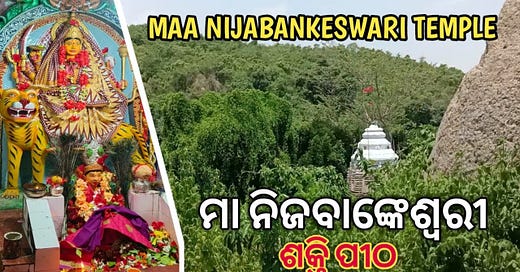Bankeshwari Peetha is one of the many shrines of Shakti Mata in Ganjam district, located 42 km southwest of Brahampur city on the eastern ghat Kerandi Mal hills. Until the end of the 19th century, this area was full of wild animals and dense bamboo forests. Upon the arrival of the Odia month of 'Chaitra’ (from March to April), branches and leaves of the bamboo forest catch fire spontaneously due to the warm weather during the summer season. Another reason given is that the tribal inhabitants have been setting fire to the bamboo forest to clear the brushwood for harvesting food grains called ‘Bagada Chasa’. As a result, Kerandi Mal mountain started to burn gradually for a long time. It is at this time that the Mata Bankeshwari (Dumula) festival is celebrated when the first fire breaks out in the bamboo forest of the upper hills and is visible from the courtyard of the Siddhi Bankeshwari temple below the hills.
Mainly, the weather of Ganjam district is said to be influenced by the Bay of Bengal climate and the environment of the Eastern Ghat Kerandi Mal-Tamana Mountain region. Whether it is the monsoon flow in the rainy season or the snow wave in the winter season, the weather here is influenced by the Kerandi Mal mountain range. During the four months of summer, Kerandi Mal forest fires can be seen from the southwest, and the heat can be felt from Brahampur city.
According to legend, when a fire breaks out in the Kerandi Mal forest, Mata Benkeswari is beseeched to prevent it from getting out of control. Among the inhabitants of Ganjam district, families engaged in agriculture and cottage industries do not have any special agricultural work in their fields during the end of Falgun and the entire month of Chaitra. This time is reserved for concentrating the mind and worshipping Mother Bankeshwari for the good health and well-being of newborn children in the family. On the occasion of Mata Bankeshwari's Yatra, family members visit the spot, and it is customary to cut off the first hair of the newborn baby completely. The practice of beautifying children, known as ‘Mundan’, is said to have been inherited from tribal culture, although middle-class families could afford to celebrate the festival together.
From every corner of the village in Ganjam district, families along with friends and relatives can be seen enjoying the festival by organizing a feast and striving to maintain family tradition. The memories of children who once reached the Bankeshwari Peetha sitting on the shoulders of their fathers and uncles, enjoying the festival with their grandson and granddaughter, are indescribable for them.
Earlier, when there were no motor vehicles, families from rural areas along with their relatives started their journey in bullock carts in the moonlight of Purnima the previous evening to reach Mata Benkswari's shrine. At midnight, after reaching Mata's pedestal, the families gather at their places in the four corners of the adjacent farmland. On the opposite side of the corner, the cart is sheltered, and the kitchen furniture they have brought is arranged to set up a wood stove.
At the last hour of the night, when the fire is visible in the bamboo forest at the upper end of the Bankeshwari Pitha, the ‘Pooja-Archana’ worship begins at the lower end of the Siddi Bankeshwari Pitha amid the sound of bells, drums, and the Yatra festival begins. Some devotees line up to enter the temple with their ‘puja’ items in their hands, eager to have a glimpse of the mother, while other family members light the fire in the wood stove in the kitchen they have set up.
At that time, till the end of the ‘Falgun’ month, the winter season dew is condensed in the climate. In the twinkling light of early morning, every corner of the farmland is covered with smoke coming out of the wood stove. As the sun rises, the gathering of devotees continues to increase. Markets selling various types of food, toys, and horticultural items line up on both sides of the road up to the Mata temple. Those who forget to bring groceries for the kitchen are busy buying salt and pepper, etc. Those who have shaved their children and put them on their shoulders are worried about queuing up for the Mata temple. In this way, the Bankeshwari Pitha is decorated in a noisy atmosphere.
After the Matas’ darshan, everyone's hunger is satisfied with ‘Panchamrit’, a fruit and dry foods mixed juice preparation. In the earthen basket, palm candy, honey, milk, curd, ghee, fried dry rice, ‘lia-dovja’, etc., are mixed with coconut and banana, which were brought from the Mata's worship, and served to each family member.
After consuming ‘Panchamrita’, adults busy themselves in the kitchen while children play with toys bought from the festival bazaar. Lunch starts at noon. Before sunset in the evening, kitchen utensils are tied to the bullock cart, and it makes its way back to the village.
After some distance from Bankeshwari Pitha, we found our kid to play with the two goats that came with his or her. They are comforted by the fact that the two baby goats have gone into the forest to join their mother. In that ‘Panchamrit Kalasi’ earthen pot, the ‘Tulsi’ plant is decorated for many days at the root of the ‘Chonora’ for many days after the journey.




